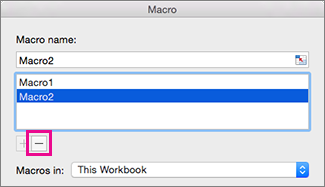
When you’re done, go to the "View" tab, click the tiny arrow below the "Record Macro" button again and select "Stop recording". Perform the actions in your spreadsheet you want to be turned into a macro. Type in the name of your macro and click "OK" to start the recording. Go to the "View" tab of the ribbon and click the tiny arrow below the "Macros" button. But it's still a handy way to get started.
HOW TO WRITE A MACRO IN EXCEL MAC CODE
You'll still need to type or edit code manually sometimes. There are limitations to this, so you can't automate every task or become an expert in automation by only recording. When you’re done, tell Excel to stop recording and you can use this new macro to repeat the actions you just performed again and again. Then you perform the tasks you want to be translated into VBA code. When you record a macro, you tell Excel to start the recording. Later on, it serves as handy storage for code that you don’t need to memorize. Recording a macro is a good way of getting to know the basics of VBA. The main focus of this article is on the former, but recording a macro is so simple and handy, it's worth exploring too. Set dest = Cells(Rows.Count, “A”).End(xlUp).There are two ways to make a macro: code it or record it. Set r = Range(Cells(1, k), Cells(1, k).End(xlDown))


J = Range(“A1”).Finish(xlToRight).Cavalcade Cel = Supersede(Cel, ” “, ” “) Finish If Next Cel Application.ScreenUpdating = True Stop Subĭim j Equally Long, m As Long, r As Range, dest As Range Word = “Theword” Application.ScreenUpdating = False For Each Cel In Range If Cel Like “*” & Word & “*” Then Cel = Supervene upon(Cel, Word, “”) ‘To remove the double space that follows.
:max_bytes(150000):strip_icc()/005-add-macros-in-excel-4176395-d5024b52141447638d2b4f88ee2561c4.jpg)
Selection Explicit Selection Compare Text Sub DeleteWord() Dim Cel Equally Range, Range As Range Dim Give-and-take As Cord Set Range = Range(“B2:B20”) ‘. *Delete a cord of character in a range of cells Sub KeepFormulas() Dim sRow, lCol Every bit Integer sRow = ActiveCell.Row lCol = Cells(sRow, Columns.Count).End(xlToLeft).Column For Each cell In Range(Cells(sRow, 1), Cells(sRow, lCol)) If cell.HasFormula = False Then prison cell.ClearContents Next jail cell End Sub *To delete information in the row while keeping the formula *To add together A-Z alphabets in a range: If IsNumeric(Mid(CellRef, i, i)) Then Upshot = Result & Mid(CellRef, i, 1)Ī(Link:=True).Select *To become merely the numeric part from a string: If Not (IsNumeric(Mid(CellRef, i, 1))) And so Result = Consequence & Mid(CellRef, i, ane) *To become simply the text part from a cord: If Not Application.CheckSpelling(give-and-take:=cl.Text) Then *To highlight the cells that have misspelled words: *To automatically insert a row afterwards every row: Cells.SpecialCells(xlCellTypeFormulas).Locked = Truthful Ws.ExportAsFixedFormat xlTypePDF, “C:UsersSumitDesktopTest” & ws.Name & “.pdf” *To save each worksheet as a carve up PDF: If Sheets(j).Proper name < Sheets(i).Name Then List of Useful Macro Codes For Excelĭim ShCount Equally Integer, i As Integer, j Equally Integer
HOW TO WRITE A MACRO IN EXCEL MAC HOW TO
To use this code, follow the instructions on how to run macros outlined above. You can find this code in your saved macros. Finally close the window and become back to your workbook. Now the new module has to appear in the left tab and you lot tin can add together a code. How to Add together a Code to the VBĪdd a code, open the workbook and printingĬull a workbook to which y’all wish to add a macro. Specific macro code, you can use the instructions and the list of the codes below. If you want to perform an action that involves a How to Apply Specific Macro Codes on Your Excel File At present your macro is saved and y’all can use it whenever y’all want. If you utilise a repetitive job in Excel and want to facilitate it. Now that you accept enabled Macros in your Excel file, you can Now you will see a Programmer tab in your principal card. To exercise then, follow the instructions below. To use Macros in Excel, you need to firstĮnable the programmer option. All you need to know is simply someĪnd how to use them in do. Macro works with VBA (Visual Basic for Awarding) programme codes, but to employ them, yous don’t accept to be a programmer at all. Macro is a handy tool for frequent Excel users that helps to salvage time and automatically configure some commands.


 0 kommentar(er)
0 kommentar(er)
